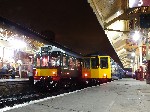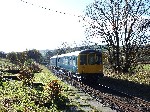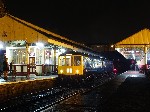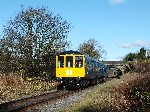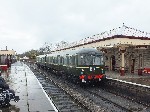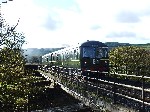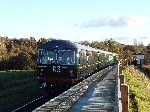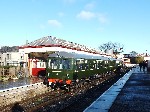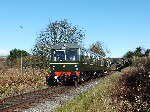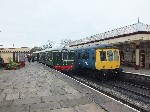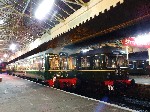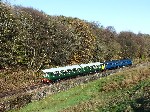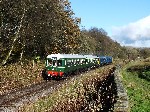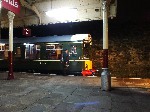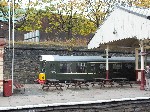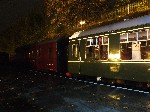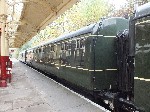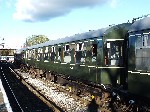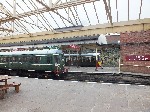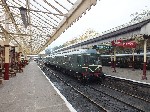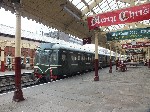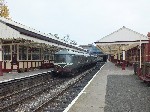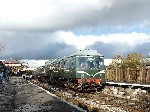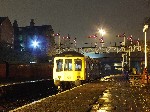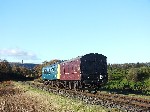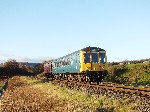22nd Annual Railcar Convention
East Lancashire Railway, 3rd-5th November 2017.
Report by Chris Moxon.
Introduction
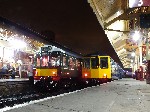 The 2017 annual Railcar Convention returned to the East Lancashire Railway, who chose to host for the second time after a gap of some 17 years. The railcar landscape at the railway had changed beyond all recognition in that time, with the Class 110 set being the only vehicles to appear in passenger service for both the 2001 and 2017 events.
The 2017 annual Railcar Convention returned to the East Lancashire Railway, who chose to host for the second time after a gap of some 17 years. The railcar landscape at the railway had changed beyond all recognition in that time, with the Class 110 set being the only vehicles to appear in passenger service for both the 2001 and 2017 events.
The proposed line up for the event was simply stunning. A total of no less than six sets were booked to be in action for the event, a total of 12 vehicles. This was the second highest total of any railcar event in preservation history, topped only by the unique (and subsidised by grants) Railcar50 event back in 2004. The fact that five of the six sets were residents, and that three of them were returning to service following the conclusion of heavy overhaul/restoration works, meant that arguably this convention was the greatest showcase of a host railway's railcar endeavours ever seen in preservation history. Without doubt, this was not to be the railcar event of the year, but the event of the decade!
Friday
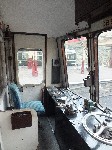 As is firmly set in tradition, Friday was dedicated to association member's driving experiences. With so many sets on site, it was no surprise that a good selection were to be available for use. It was originally intended for the Class 104 and 110 sets to be available due to their raucous acceleration and audio tendencies, however close to the event it was apparent that the overhaul work on both of these sets would be ongoing right up until the start of services on the Saturday! As a result, the three available sets were the visiting Class 109, Class 117 and Class 122 "bubble car". Looking back, it was nice to have the 117 and 122 shuttling up and down on the Friday, as these two sets got the smallest slice of the cake when it came to the diagrams thy ran on the Saturday/Sunday.
As is firmly set in tradition, Friday was dedicated to association member's driving experiences. With so many sets on site, it was no surprise that a good selection were to be available for use. It was originally intended for the Class 104 and 110 sets to be available due to their raucous acceleration and audio tendencies, however close to the event it was apparent that the overhaul work on both of these sets would be ongoing right up until the start of services on the Saturday! As a result, the three available sets were the visiting Class 109, Class 117 and Class 122 "bubble car". Looking back, it was nice to have the 117 and 122 shuttling up and down on the Friday, as these two sets got the smallest slice of the cake when it came to the diagrams thy ran on the Saturday/Sunday.
The line was split into three separately worked sections, with one set shuttling backwards and forwards on its own section for the day. The scenic Rawtenstall-Ramsbottom section, the northernmost leg of the line, was used by the Class 109 which was available for qualified railcar drivers only. The middle section, Bury-Ramsbottom, was in the hands of the Class 122 whilst the Bury-Heywood "extension" was covered by the Class 117.
Each section had its own merits for the participants. The Class 109 on the northern section was swallowed up by the scenery which is remarkably good for what is considered by outside visitors to be quite a built up area. The green livery certainly matched the trees! The middle section was fairly similar in terms of scenery although slightly less open. The line twisted and turned keeping driving interesting, and the curves were exacerbated by the use of the "bubble" which rolled from side to side as it went along. Intermediate stations and two tunnels added to the interest. The final section, Bury-Heywood, was probably the least scenic, however this was balanced by other curiosities including the humped section known as the "Ski Jump" to get the railway over the Metrolink tram line, the steady gradient almost all of the way (4 miles) which kept the unit working, plus the enthusiastic instructor who was more than happy to point out all of the hidden features along the way. All in all a fantastic offering totalling up to 24 miles, which was enjoyed by all of the participants questioned afterwards!
Friday Evening
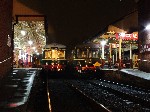 After the experiences had finished, use was made of the sets stabled in the platforms at Bury overnight for a organised photo charter. Volunteers in period dress and some props were used to create scenes which were avidly photographed by participants. Sets in use for the charter were the 105, 109 and 110, with the 122 loitering at the back of the station which, although not formally part of the shoot, did provide its own scene under the gantry signal, using nearby street lighting to illuminate it! He 109/105 combination provided a distinctly East Anglian scene, whilst the 105/110 made a much more northern atmosphere, particularly given the stone platforms and retaining walls that surrounded us. A headboard was placed on the 105 for part of the evening to recreate the last train in 1966 to Accrington, which was operated by a 105.
After the experiences had finished, use was made of the sets stabled in the platforms at Bury overnight for a organised photo charter. Volunteers in period dress and some props were used to create scenes which were avidly photographed by participants. Sets in use for the charter were the 105, 109 and 110, with the 122 loitering at the back of the station which, although not formally part of the shoot, did provide its own scene under the gantry signal, using nearby street lighting to illuminate it! He 109/105 combination provided a distinctly East Anglian scene, whilst the 105/110 made a much more northern atmosphere, particularly given the stone platforms and retaining walls that surrounded us. A headboard was placed on the 105 for part of the evening to recreate the last train in 1966 to Accrington, which was operated by a 105.
Friday evening was finished off nicely by a consortium of members heading for one of the local pubs in Bury. It has been noticed over the past few years that members are choosing to get together and have an evening meal on the Friday evening of the event. Whilst not wishing to over formalise a natural event, it may be considered to be fast becoming a feature of the event, a new tradition for members?
Saturday
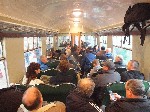 Saturday saw the doors flung open to the public and what a start to an event! The first departure from Bury was 09:00 and I have personally never seen a train that early in the morning at a convention so full! There was however a very good reason for this: the set on that departure was the unique and last surviving Cravens Class 105 2-car set, which had been out of service undergoing a major rebuild for the past 21 years no less. Whilst railcar enthusiasts had been well served up until 2010 by the other surviving Cravens trailer car (56456) at the Llangollen Railway, it was not quite the same as a full set (including powercar), so the return of the 105 after so long was most welcome. The quality of restoration was clearly top notch, with not mark to be found outside or inside. The 105 now takes its place on the top table of railcar restorations in the country.
Saturday saw the doors flung open to the public and what a start to an event! The first departure from Bury was 09:00 and I have personally never seen a train that early in the morning at a convention so full! There was however a very good reason for this: the set on that departure was the unique and last surviving Cravens Class 105 2-car set, which had been out of service undergoing a major rebuild for the past 21 years no less. Whilst railcar enthusiasts had been well served up until 2010 by the other surviving Cravens trailer car (56456) at the Llangollen Railway, it was not quite the same as a full set (including powercar), so the return of the 105 after so long was most welcome. The quality of restoration was clearly top notch, with not mark to be found outside or inside. The 105 now takes its place on the top table of railcar restorations in the country.
Further departures from Bury populated the line with the Class 122 hauling a maroon CCT as a tail load, and the visiting 109 heading for Heywood to start services in that direction. The 109 was also popular as it was of course the visiting unit, so completely unfamiliar with the surroundings of East Lancs. The 109 had been repainted during the last 12 months, one of four sets to have been treated so recently, so was looking its best.
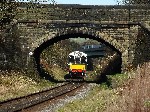 Next to depart was the Class 110 "Calder Valley" hauling an LMS Stove R, believed to be only the second time in preservation that two DMU tail loads have been out at an event at once. The Class 110, the only 3-car set running at the event, was also being relaunched following overhaul. It had been over 10 years since the set had operated as a full 3-car formation, as its previous home (the Wensleydale Railway) had split the set up and operated it in various combinations before it fell out of use. A huge amount of effort and overhaul work had been spent on the Class 110 over the last few years to get all three cars back together and in service once more. The 110 restoration was notable for being the fastest turnaround of all the sets debuting, with an astonishing amount of work achieved in a small space of time.
Next to depart was the Class 110 "Calder Valley" hauling an LMS Stove R, believed to be only the second time in preservation that two DMU tail loads have been out at an event at once. The Class 110, the only 3-car set running at the event, was also being relaunched following overhaul. It had been over 10 years since the set had operated as a full 3-car formation, as its previous home (the Wensleydale Railway) had split the set up and operated it in various combinations before it fell out of use. A huge amount of effort and overhaul work had been spent on the Class 110 over the last few years to get all three cars back together and in service once more. The 110 restoration was notable for being the fastest turnaround of all the sets debuting, with an astonishing amount of work achieved in a small space of time.
Shortly afterwards the 117 set joined the 122 on its shuttle service from Bury to Ramsbottom. The 117 was overshadowed somewhat by the other sets in service for the event, being a unit on-hire to the railway rather than a resident. However, with all the overhaul works going on over the past 5 years the Class 117's stay has been greatly beneficial to the railway and it has served them well. With the hire contract expired, this event was the final chance to travel on the 117 at the ELR before its place in the fleet was taken by others.
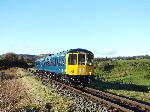 The last set to join the party was the mighty 104 set, although I would say that being slightly biased! The event saw the return to service of the 2-car set formerly resident at the Churnet Valley Railway, and last experienced by members ten years ago when the Churnet held the convention back in 2007. The 104 had been out of service for three years for an exterior overhaul and conversion from 1960's green condition to late 1970's/early 1980's blue. This set was the most likely to "miss" the event as overhaul works on the motor brake half of the set, M50455, required the most work to finish off in the final weeks leading up to the event! A string of 14 hour days and some serious help from other volunteers from the railway and other DMU groups meant that the set JUST made it! To put this into perspective, the Friday evening saw much of the dismantled interior reassembled just hours before passengers were due! I think I speak for the owning group by offering sincere thanks to those involved in the "final push" to allow the 104 to make the event.
The last set to join the party was the mighty 104 set, although I would say that being slightly biased! The event saw the return to service of the 2-car set formerly resident at the Churnet Valley Railway, and last experienced by members ten years ago when the Churnet held the convention back in 2007. The 104 had been out of service for three years for an exterior overhaul and conversion from 1960's green condition to late 1970's/early 1980's blue. This set was the most likely to "miss" the event as overhaul works on the motor brake half of the set, M50455, required the most work to finish off in the final weeks leading up to the event! A string of 14 hour days and some serious help from other volunteers from the railway and other DMU groups meant that the set JUST made it! To put this into perspective, the Friday evening saw much of the dismantled interior reassembled just hours before passengers were due! I think I speak for the owning group by offering sincere thanks to those involved in the "final push" to allow the 104 to make the event.
With all the sets on the move, an intensive day of railcar operations followed with only a few minor air issues with the 104 (losing a few minutes), and an electrical niggle with the 110 (which saw it lose a round trip). However given the amount of units fresh out of overhaul, it was a credit to those involved that all services ran, close to advertised time for much of the day.
One highlight during the afternoon was an arranged "Class 40 drag" using the 104 paired with a matching blue 40135. Despite recreating one of the less-fortunate elements of DMU's on BR, failures, it was very popular with visitors with the train full of passengers (looks like they best crack on with the 104 centre car at Bury then!). The only unfortunate element of the drag was that it coincided with the association's AGM, so we had to watch the Class 40 whistle past as we attended to formal matters!
Formal Meeting
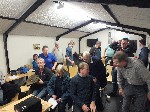 As mentioned above, Bury was the venue for the association's AGM during the Saturday afternoon, which started at 15:30 following some technical issues with the computer, which were solved by borrowing the ELR General Manager's keyboard and mouse! A total of 41 members were present, which was pleasing as the figure had dropped at the previous convention by around 25% so it was nice to see attendance back to what we consider normal levels.
As mentioned above, Bury was the venue for the association's AGM during the Saturday afternoon, which started at 15:30 following some technical issues with the computer, which were solved by borrowing the ELR General Manager's keyboard and mouse! A total of 41 members were present, which was pleasing as the figure had dropped at the previous convention by around 25% so it was nice to see attendance back to what we consider normal levels.
Apologies included Kevin Dowd (outside driving the 104!), Ritchie Marcus (Battlefield Line) and Andrew Goodman. This was followed by Paul Moxon's "Chairman's Welcome" which reported on a fairly normal year.
Chris Moxon presented the usual round-up of the year regarding vehicles. There had been two new additions this year: Class 121 55020 (ex Chiltern) and Swedish Railcar 1987 (imported). Disposals included rare Class 100 56317 and Class 115 51677. The Helston Class 103, Class 115 51655 and Class 117 3-car set at Eastleigh Works were all considered at risk of disposal. Moving onto movements, The East Kent Railway had shed all of its railcars with the 101 set going to Wensleydale and the 108 being returned to the National Railway Museum at York. Two Class 117 DMBS vehicles had moved from the private site at Titley Junction to the Gloucestershire Warwickshire. Drewry Railcar 998901 was the only vehicle to move around for contract works this year, going to the Keighley & Worth Valley for repairs following its arson attack. Finally, in the "events and loans" section, Derby Lightweight Iris had visited the Llangollen railway for their gala, whilst Llangollen's own 109 was at the East Lancs for theirs. Additionally, the Colne Valley Raiwlay Class 121 trailer had moved to the Epping and Ongar on hire to operate with their Class 117. Moving onto overhauls, it was recognised that it was hard to keep track on some vehicles, however it was estimated that six new restoration projects had been started this year, with a healthy 12 reaching completion, including of course the notable Class 105 set. To conclude, a summary page showed that there was now 280 railcars preserved (-1 from last year), 150 were operational (+6) and 46 were under restoration (+2). Overall a good year, with the movement increasing both the number of railcars in service and the number being restored.
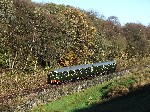 The highlight of the meeting was the historical talk which this year was provided by Steve Hoather, a professional railway engineer who was the depot foreman at Cambridge. He knew Tim Stubbs (who hosted a talk on Norwich two years ago) as he was Steve's counterpart at Norwich. Steve presented a fascinating insight into the Kings Cross Suburban Cravens fleet maintained at Cambridge, which was very appropriate given that this year was clearly the year of the 105! His introduction to the topic was the reason for the 105's use in the Kings Cross area. The 1955 Modernisation Plan saw the East Coast route planned to be electrified in parallel with the West Coast but delays with this led to stop gap dieselisation. Crucially, there were key tunnels in the area with sharp curvatures which led to the banning of full length, 64ft stock, which precluded the use of the entire suburban fleets of railcars which were all based on the 64ft chassis. Also at this time, the closure of the entire Midland & Great Northern system in East Anglia in 1959 led to a fleet of Class 105's intended for these route becoming available. And so it came to be that these unsuitable sets were put to use on the Great Northern (GN) suburban lines. They were unsuitable because they were 2-car sets (lots of surplus brake vans and cabs in long formations which wasted passenger space) and low density (limited seating and doors). Specialist railcar depots were built at Norwich, Cambridge, Sheffield and Stratford with a proposed one at Ipswich which was cancelled due to the Beeching cuts. All of the exams on the GN fleets were done at Cambridge, this "temporary" dieselisation arrangement lasting some 16 years! Steve went on to describe some of the technical modifications to the GN 105's which included trip cocks, first class declassification, larger radiators (to prevent overheating during long periods inside single track tunnels) and header tanks, repositioned saloon thermostats, the fitting of AWS, modified 5 mount engine mountings (which destroyed the classic "Cravens rattle"!), fuel filler extensions and the East Anglian bodyside panel behind the cab designed to protect the paintwork from flying token exchanges. Steve then mentioned other classes of DMU transferred for use on the GN lines, some less well known. These included 4 or 5 2-car Class 101 sets, which were transferred through a quirk of BR bureaucracy. At the time BR classed its railcars into A, B and C depeneding on their worthiness for re-use. Class 101's were "A" i.e. suitable for life extension/investment, whilst Class 105's were "B" i.e. keep them maintained but not for life extension. (C was reserved for non standard types such as the Cickham 109's and park Royal 103's which were to be replaced as soon as practicable). As sets for the GN lines required the modifications listed above, BR could not justify sending more 105's to join the others already in use, which would have made more sense, as 105's were classed "B", so some "A" class 101's were sent instead, unnecessarily creating a mixed fleet! Other sets included 116's and 125's which were transferred to work various other services which they could operate given their 64ft lengths. Steve finished by mentioning that the final demise of the 105 fleets was, as expected, the eventual electrification of the lines on which they operated.
The highlight of the meeting was the historical talk which this year was provided by Steve Hoather, a professional railway engineer who was the depot foreman at Cambridge. He knew Tim Stubbs (who hosted a talk on Norwich two years ago) as he was Steve's counterpart at Norwich. Steve presented a fascinating insight into the Kings Cross Suburban Cravens fleet maintained at Cambridge, which was very appropriate given that this year was clearly the year of the 105! His introduction to the topic was the reason for the 105's use in the Kings Cross area. The 1955 Modernisation Plan saw the East Coast route planned to be electrified in parallel with the West Coast but delays with this led to stop gap dieselisation. Crucially, there were key tunnels in the area with sharp curvatures which led to the banning of full length, 64ft stock, which precluded the use of the entire suburban fleets of railcars which were all based on the 64ft chassis. Also at this time, the closure of the entire Midland & Great Northern system in East Anglia in 1959 led to a fleet of Class 105's intended for these route becoming available. And so it came to be that these unsuitable sets were put to use on the Great Northern (GN) suburban lines. They were unsuitable because they were 2-car sets (lots of surplus brake vans and cabs in long formations which wasted passenger space) and low density (limited seating and doors). Specialist railcar depots were built at Norwich, Cambridge, Sheffield and Stratford with a proposed one at Ipswich which was cancelled due to the Beeching cuts. All of the exams on the GN fleets were done at Cambridge, this "temporary" dieselisation arrangement lasting some 16 years! Steve went on to describe some of the technical modifications to the GN 105's which included trip cocks, first class declassification, larger radiators (to prevent overheating during long periods inside single track tunnels) and header tanks, repositioned saloon thermostats, the fitting of AWS, modified 5 mount engine mountings (which destroyed the classic "Cravens rattle"!), fuel filler extensions and the East Anglian bodyside panel behind the cab designed to protect the paintwork from flying token exchanges. Steve then mentioned other classes of DMU transferred for use on the GN lines, some less well known. These included 4 or 5 2-car Class 101 sets, which were transferred through a quirk of BR bureaucracy. At the time BR classed its railcars into A, B and C depeneding on their worthiness for re-use. Class 101's were "A" i.e. suitable for life extension/investment, whilst Class 105's were "B" i.e. keep them maintained but not for life extension. (C was reserved for non standard types such as the Cickham 109's and park Royal 103's which were to be replaced as soon as practicable). As sets for the GN lines required the modifications listed above, BR could not justify sending more 105's to join the others already in use, which would have made more sense, as 105's were classed "B", so some "A" class 101's were sent instead, unnecessarily creating a mixed fleet! Other sets included 116's and 125's which were transferred to work various other services which they could operate given their 64ft lengths. Steve finished by mentioning that the final demise of the 105 fleets was, as expected, the eventual electrification of the lines on which they operated.
The remainder of the meeting was occupied with discussions on other topics. Lottery Grants were mentioned, specifically in relation to Grinsty Rail seeking funding to restore the unique Class 120 buffet car at the Great Central Railway. It emerged through discussions that the previously successful railcar lottery grant winners, the 109 and 126 projects, had both "sneaked through" whilst the lottery system was still being properly formed, at a time when they didn't fully know themselves what sort of projects they wanted to fund. Things have settled down since then, with the latest conditions becoming too stringent to meet. All of the DMU lottery grant applications during the last 15 years have failed. It was felt that the lottery fund was not currently set up in favour of railcars, as they are currently giving either small grants (too small to restore a railcar) or a small number of very large grants (for projects much larger than a DMU restoration). We sat uncomfortably in the middle of the two. It was advised that Grinsty Rail seek alternative sources of grants away from the HLF, however general advice regarding filling out application forms (which is a skill in itself) was offered by those who had been there before.
Some discussion took place on the difficultly in getting new parts made. Items such as tyres were proving difficult with examples from india being of poor quality whilst other items really have been reaching the end of their lives, i.e. overhaul is now not enough, these components now need full replacement. Production and tooling costs were proving too great for individuals and railways, even when clubbing together. Some examples of potential projects which have fallen by the wayside included new bearings for final drives/axles, which were proving to be five figure sums. It was mentioned that research & development costs are being funded by the government if they are required by charities, the question was raised that should the Railcar Association seek charitable status? There was some opposition in the form that the association has always been steadfastly not a financially based organisation (there is no membership fee and very few "running costs") however it was mentioned that simple charities can be set up for very little finance. Given these facts, it was descided by the floor that Evan Green Hughes, who has good experience in small charities, would seek to investigate the options and implications for TRA becoming a charity over the next 12 months and report back at the next meeting.
The subject of the next conventions was discussed. A provisional idea to go to a new location, the Epping & Ongar Railway, had been discussed prior to the meeting on the basis that if members were interested, Epping would be approached again and we would seek to go there next year. There was also an offer by the Weardale Railway which is looking to expand its railcar fleet soon. Given the options it was recommended that we seek an invitation to the Epping & Ongar for 2018 with Weardale to follow in 2019. It was considered desirable not to clash with the Heritage Railway Association annual event which is held in September.
The final presentation returned to the Chairman who presented a more enthusiast-angled Class 105 photo selection, taken by himself in North West England during the final few years of the Class in service.
Saturday Evening Fish & Chip Special
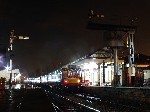 With the meeting concluded, a quick drink in The Trackside pub was the next move for many members, the pub being conveniently located on the same platform as the meeting room! The Fish & Chip special, scheduled to depart at 18:45, proved to be a bit of a "mystery tour" with rumours as to its final formation being circulated in the hours before which was fun! Would they run everything coupled together in a 12 car set? In an almost BR/mainline situation, members were unsure as to what would be included on the run. At one stage, the 105 ran through the station empty (surely they wouldn't allow greasy chip wrappers inside the Cravens?!?) only to stable on an adjacent platform! In the end, a distinctly Birmingham RC&W themed formation emerged, with the 110, 104 and 109 providing a 7 car set, the longest in use over the weekend. The special itself ran without a hitch, Bury-Ramsbottom-Heywood-Bury, returning to Bury at 20:43. The after-dark run with tungsten lighting proved to be very atmospheric indeed, particularly those who managed to grab seats in one of the four First Class saloons available within the train!
With the meeting concluded, a quick drink in The Trackside pub was the next move for many members, the pub being conveniently located on the same platform as the meeting room! The Fish & Chip special, scheduled to depart at 18:45, proved to be a bit of a "mystery tour" with rumours as to its final formation being circulated in the hours before which was fun! Would they run everything coupled together in a 12 car set? In an almost BR/mainline situation, members were unsure as to what would be included on the run. At one stage, the 105 ran through the station empty (surely they wouldn't allow greasy chip wrappers inside the Cravens?!?) only to stable on an adjacent platform! In the end, a distinctly Birmingham RC&W themed formation emerged, with the 110, 104 and 109 providing a 7 car set, the longest in use over the weekend. The special itself ran without a hitch, Bury-Ramsbottom-Heywood-Bury, returning to Bury at 20:43. The after-dark run with tungsten lighting proved to be very atmospheric indeed, particularly those who managed to grab seats in one of the four First Class saloons available within the train!
Sunday
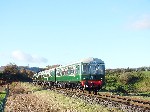 For those who were making a full weekend of it, Sunday provided another full chance to sample the intensive railcar service. The format was roughly similar to Saturday's with all six sets in operation, interspersed with tail loads and multiple workings. The day saw some interesting combinations, with the 117/122 forming a suburban pairing, the 109/104 pairing up to form a scene reminiscent of similar combinations they operate at Llangollen galas, and a 105/109 combo which was pure East Anglian in character.
For those who were making a full weekend of it, Sunday provided another full chance to sample the intensive railcar service. The format was roughly similar to Saturday's with all six sets in operation, interspersed with tail loads and multiple workings. The day saw some interesting combinations, with the 117/122 forming a suburban pairing, the 109/104 pairing up to form a scene reminiscent of similar combinations they operate at Llangollen galas, and a 105/109 combo which was pure East Anglian in character.
The Class 110 was not left out, as that set was selected for the arranged "Class 40 drag", with a matching green liveried 40106 providing the honours. This proved very popular and all three vehicles were required! The 110 also had the dubious honour of signing out the event, as it rumbled into Bury station on the last arrival of the weekend, drawing to a close one of most enjoyable conventions that I could personally remember.
Gallery

